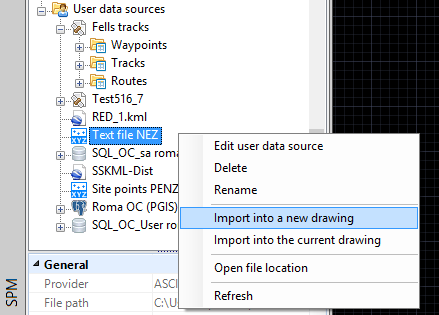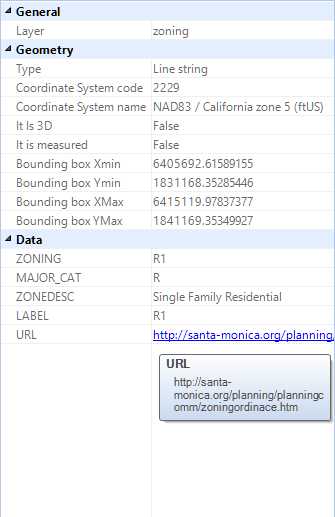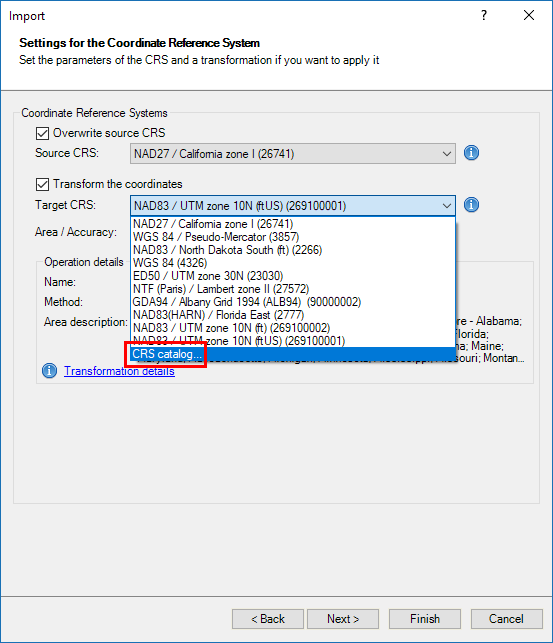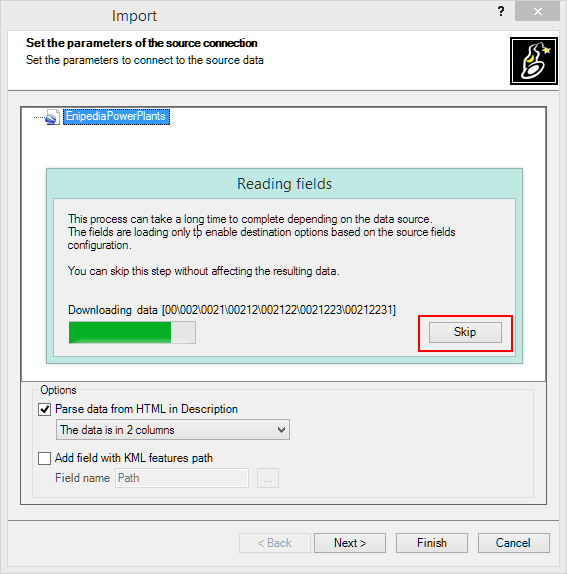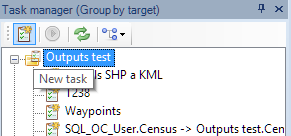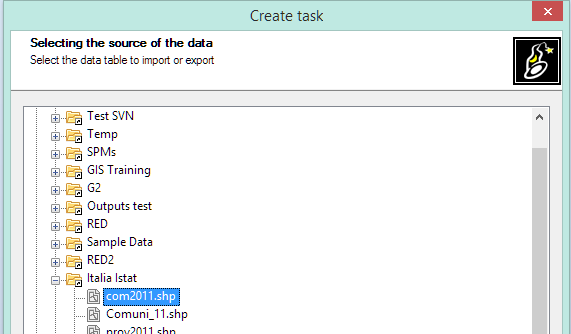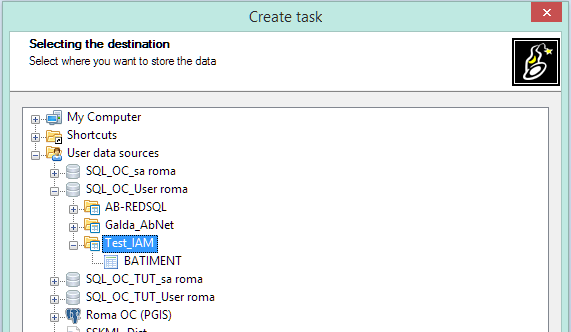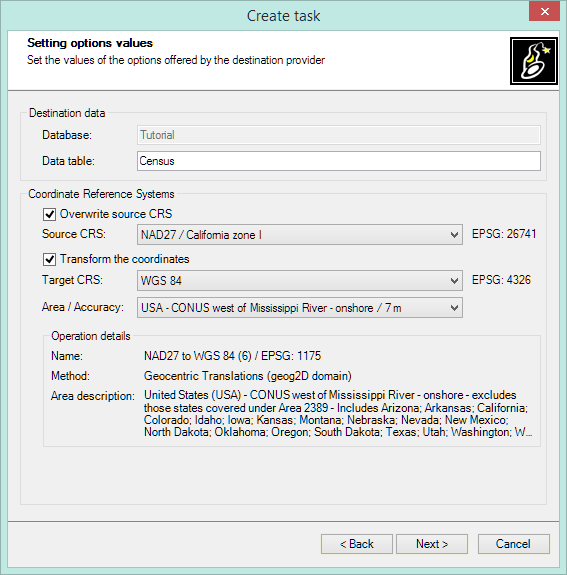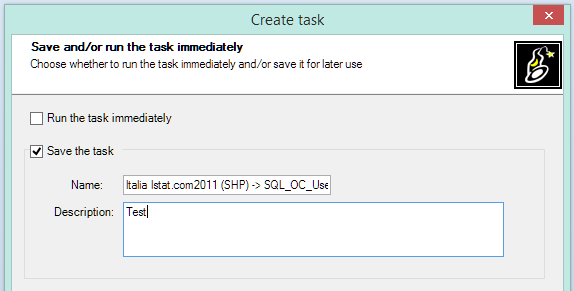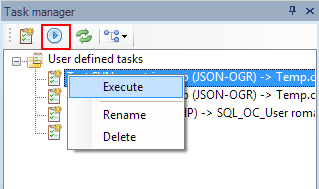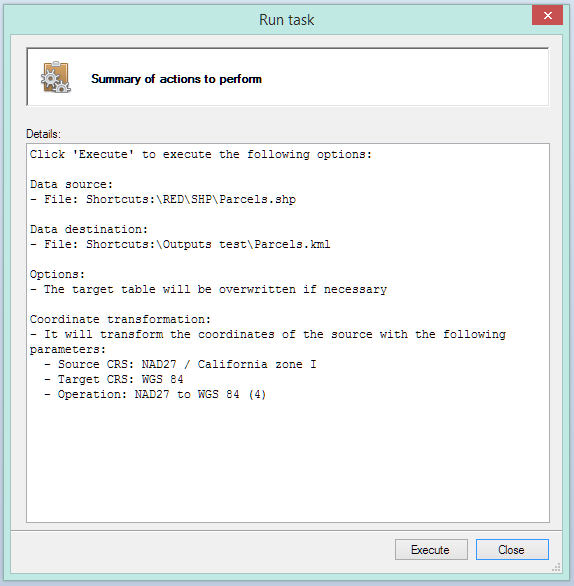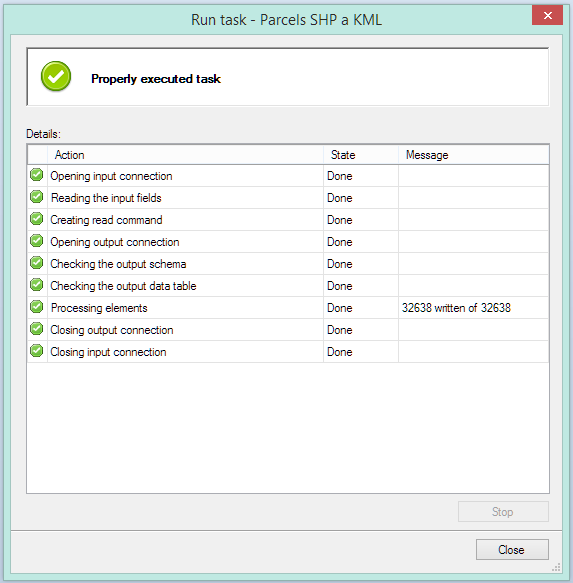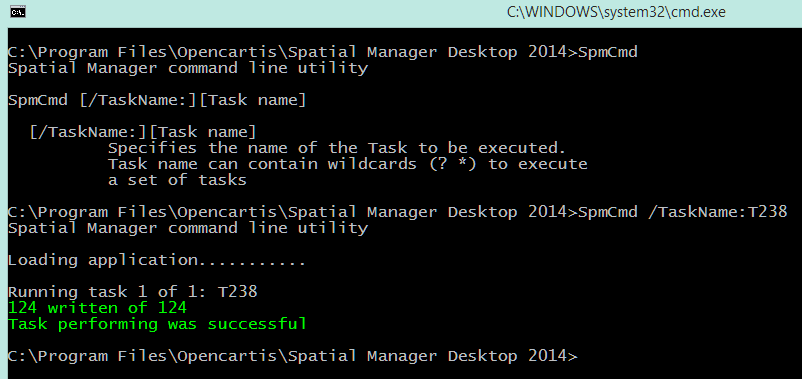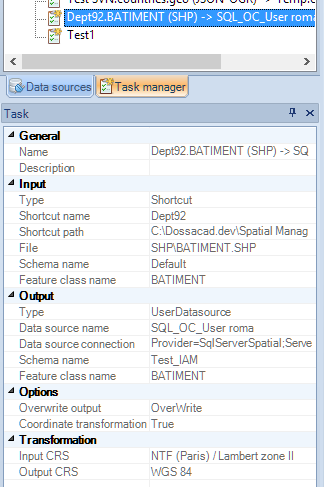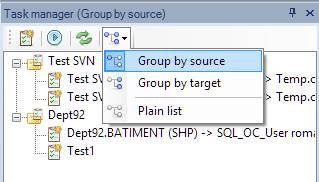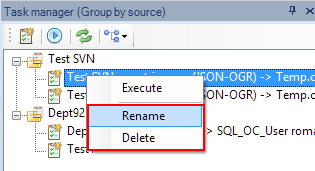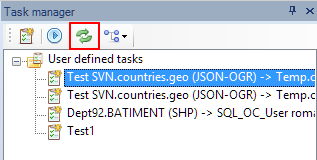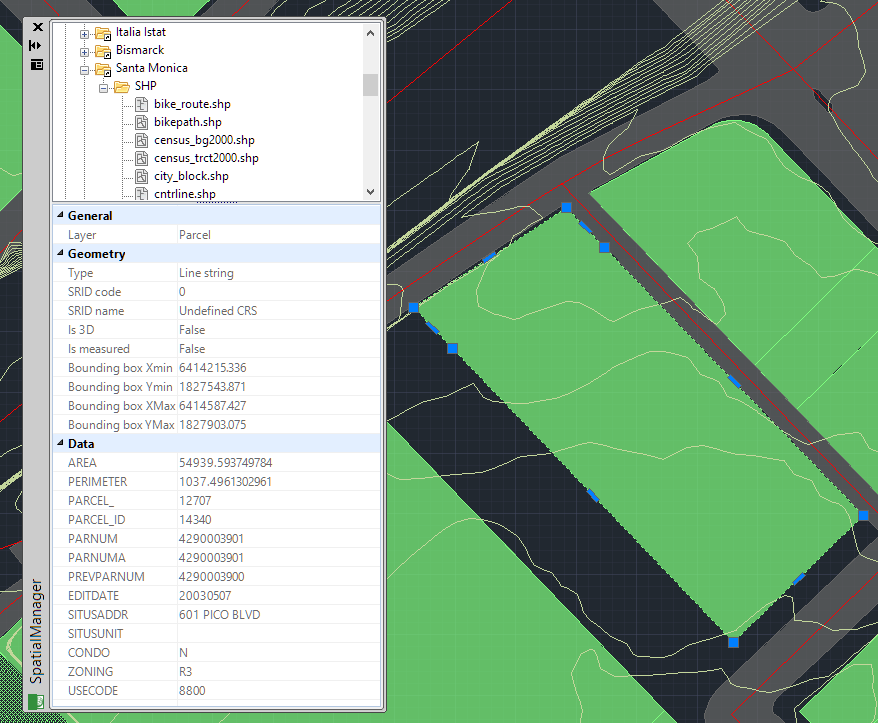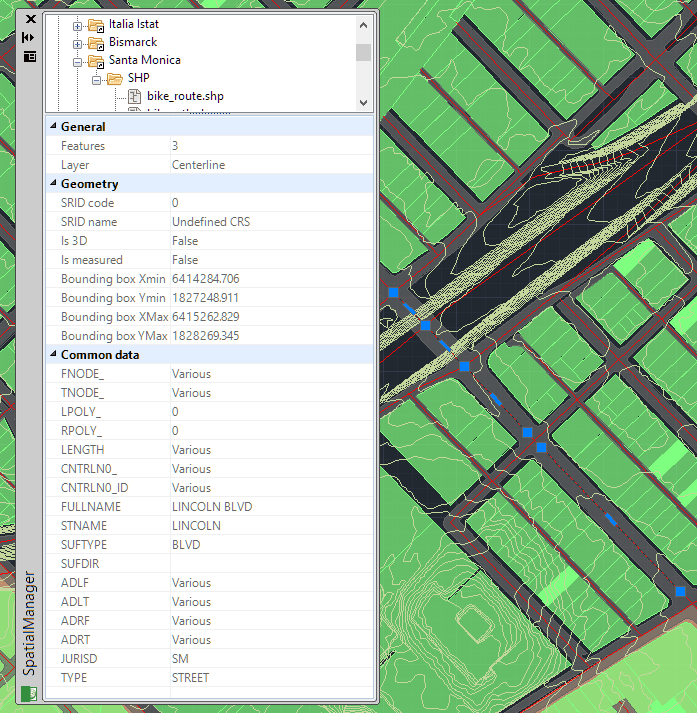Difference between revisions of "Spatial Manager™ for BricsCAD - FAQs: Import"
m |
m |
||
| Line 102: | Line 102: | ||
| − | [[Image: | + | [[Image:ACADTask-1.PNG|border]] |
Revision as of 10:12, 4 May 2015
Introduction
- Objective of this section
- To learn how to define import processes and their parameters and manage coordinate transformations
- Topics in this section
- Sources: data sources
- Import parameters: BricsCAD Entities parameters, hatches, BricsCAD properties, Extended Entity Data (EED) ("Standard" and "Professional" editions only)
- Transforming the coordinates: source and target, favorite coordinate systems, searching in the coordinate systems table and transformation parameters
- Tasks: save and replay import processes, manage tasks
How can I Import spatial Features as BricsCAD Entities?
You can Import spatial Features as BricsCAD Entities into Spatial Manager™ for BricsCAD by using the context menu (mouse right-click) on any table or spatial file in the "Data sources" area of the "SpatialManager" palette. This will launch the "Import" wizard of the application. As you will see, you can import the table or the file in the current or a new drawing (see also "How to import directly into the current drawing?" below).
While running the "Import" wizard, you can select the Import parameters that match your needs:
- Points and Centroids options. Here you can define the options for point type Features and for centroids of Polygons (if you choose any option to draw centroids in the Polygons options). This area will be disabled if the application "knows" there are no points or centroids to draw
- Import as BricsCAD Points
- Import as Blocks. This item will be disabled if there are no Block definitions in the drawing
- Select a Block definition
- Block options. Here you can choose the correspondence between Fields (if any in the data source) and Block Attributes (if any in the Block definition), and the Block Insertion parameters, such as the Rotation and the Scales, from values of Fields in the data source. This item will be disabled if there are no Attributes in the Block definition and there are no numeric Fields in the data source
- Lines and Borders options. Here you can define the options for lineal type Features and for borders of Polygons (if you choose any option to draw borders in the Polygons options). This area will be disabled if the application "knows" there are no lines or borders to draw
- Import as BricsCAD Polylines, Polylines 2D or Polylines 3D
- Insert Nodes (of Polylines) as BricsCAD Points
- Polygons options. Here you can define the options for polygonal type Features. This area will be disabled if the application "knows" there are no polygons to draw
- Import as Borders and/or Centroids
- Fill areas using Hatches. This item will be disabled if you have chosen the option to import as "Only Centroids"
- Hatch options. Here you can define the options for the Hatches such as Pattern, Angle and Scale (except for "Solid" pattern), Apply Transparency to the Hatch (only for "Solid" pattern and whenever BricsCAD supports the Transparency property) and if the Hatch is Associative or not
- BricsCAD Properties
- Destination Layer name. You can select an existing Layer in the drawing or you can write the name to create a new Layer (the application will propose a suitable name for the incoming table)
- Use Field values for destination Layer. Here you can select any Field to define its value as the name of the Layer for the imported Entities. If this value is null for any Entity, the Entity will be drawn in the Layer selected as "Destination Layer" in the previous item
- Apply random colors to new Layers
- Use Field values for Entity Elevation and/or Thickness
- Import as 2D Entities (Z coordinate will be ignored). This option lets you "flatten" all the imported entities on the XY plane
- Import Features data as Extended Entity Data (EED) ("Standard" and "Professional" editions only). If you choose this option, when you select Entities in the drawing, you will see the EEDs in the "Properties" area of the "SpatialManager" palette
- Note: the fields whose value starts with "http" are automatically converted into active links
How can I define a Transformation of coordinates?
When you are Importing Features as BricsCAD Entities using Spatial Manager™ for BricsCAD, you will see that you can choose a Transformation of coordinates from the source Features to the Entities in the drawing, in the "Import" wizard. This means that the application will calculate a geometric transformation between the source and the target data, which will depend on the chosen CRS for the source (incoming Features) and for the target (imported BricsCAD Entities) data. You can choose the appropriate CRSs by clicking on "CRS catalog...", in the CRS dropdown list for the source or for the target data. In the CRS table you can:
- Filter the CRSs by type (Geocentric, Projected, etc.)
- Choose a CRS by clicking on its row in the table
- Search CRSs by typing the search criteria in the "Search" box. You can type here as many words as you like separated by blanks. The application will find all the rows including all these words in a column of the table
After choosing a pair of valid CRS for a Transformation, you can choose the geographic Area to apply it to (the application will choose by default the most common Area for this Transformation)
If the application "knows", "guesses" or "can assume" the CRS of the source and/or the target (drawing) data, it will be chosen by default. You will be able to modify this choice except in cases where only one CRS is valid; for example, for a KML or a KMZ file the only valid choice is the CRS "WGS84 (SRID 4326)", because these types of file are always defined using this CRS
You can assign a CRS to the drawing, or modify it, using the command 'SPMSETCRS'. By executing this command you will access the CRS catalog of the application, described in the previous lines
- When importing a table defined using a known CRS into a drawing without an assigned CRS, the CRS of the table is automatically assigned to the drawing
- If you change the target CRS by choosing any CRS other than the drawing CRS, you will get a warning from the application but you can continue and perform the Transformation of coordinates if you want to
Notes:
- As you will see, the CRS dropdown lists will include more and more CRSs as they have been previously chosen in other Transformation operations, so that you can choose your "favorite" CRSs directly from the dropdown list without having to access the CRS Table all the time
-If the incoming data is defined using the CRS "WGS84 (SRID 4326)" and the drawing has not assigned any CRS, the transformation to the CRS "WGS 84 / Pseudo-Mercator (SRID 3857)" is selected by default to get a projected map instead of a flat representation of geodesic coordinates
Spatial Manager™ for BricsCAD SETSPMCRS command
How can I speed up the starting Import process?
Sometimes, depending on the characteristics of the source, the initial reading of the data Fields may take a long time or even block the Importing process. Spatial Manager™ for BricsCAD performs this startup reading to allow you to choose certain options relating to this data on the next wizard window, such as the use of the field values to define the target Layers for the imported Entities. However you have a button available to "Skip" this step, which does not affect the imported Entities themselves but only certain options that may not be available in the Importing process
How can I speed up the Import wizard steps?
To speed up the process when you are importing, all the "Import" wizard windows in Spatial Manager™ for BricsCAD include the "Finish" button. By pressing this button, you will directly run the Import process. The wizard will assume the default values in each step to be omitted
What are the Tasks? ("Professional" edition only)
The Tasks in Spatial Manager™ for BricsCAD are the way you can save any import process and its parameters, that have been designed to let you run, whenever you want, repetitive processes for import data tables in BricsCAD. You can access Tasks through the "Task manager" area in the "SpatialManager" palette
The processes of importing tables from files, servers or data stores in BricsCAD may be executed on a regular basis and sometimes these processes require the introduction of several more or less complex parameters of the source and the importing process itself, perform a coordinate transformation between the origin and target (drawing), etc. Spatial Manager™ for BricsCAD brings to you the concept of “Task”, that allows you to store all needed operations and parameters for any import process of spatial information. Once all necessary operations and parameters are saved as a Task, you can then run it from the Task Manager whenever you need
How can I create a new Task? ("Professional" edition only)
You can create new Tasks in Spatial Manager Desktop™ using the "New task" button, in the "Task manager" panel, to start the "Create task" wizard, but you can also create new Tasks when you are defining any import/export process (except when exporting a Layer or when exporting a Features Selection) because you will then run the same application wizard
When you create a new Task, you will need to enter all the parameters to access origin and target data tables, the coordinate system transformation parameters (optional), the name of the Task and a description of the Task (optional). All this data is saved, into the "Task manager", as a new Task, until you want to delete it. Note that if you want to use a read-only UDS, you will be able to read data through this UDS (valid as origin) but not to write data (not valid as target)
How can I execute a Task? ("Professional" edition only)
You have two ways of executing Tasks in Spatial Manager Desktop™
The first way, directly in the application. To execute the selected Task, use the right-click menu over the Task name itself and click on "Execute", use the "Execute" button or double-click on the Task name, in the "Task manager" panel. This will start "Run start" where you will firstly see all the data of the Task and, if you want to, execute it
When executing the Task you will see a window showing all the actions performed by the Task and, if you want to, you can cancel it before the end
The second way, through the operating system command window. You have to open a command window in the folder where the program is installed, execute the command "SpmCmd", its parameter "/TaskName:", and the name of the Task to execute, where you can use wildcards such as "*" to execute several Tasks from one only command. Every time a Task has been executed, you will get a resume line showing the number of Features exported, if the Task performing was successful, or any error message that could be produced in the process
Can I see the Properties of a Task? ("Professional" edition only)
Yes, you can see the Properties of the selected Task in the "Properties" panel in Spatial Manager Desktop™
Can I sort the Tasks in the "Task manager" panel? ("Professional" edition only)
You cannot change the relative positions of the Tasks in the "Task manager" panel, but you can sort the Tasks in Spatial Manager Desktop™ by selecting the "Sort" button in this panel as follows:
- Group by source: you will see the Tasks grouped by their source data source
- Group by target: you will see the Tasks grouped by their target data source
- Plain list: you will see a list of all Tasks sorted by date of creation
Are there any other functions for the Tasks? ("Professional" edition only)
Yes, you can Delete and Rename the Tasks in Spatial Manager Desktop™ using the right-click menu over the Task item, in the "Task manager" panel. You can also "Refresh" the Task list, using the "Refresh" button in the "Task manager" panel, if you make changes to your data sources in the current work session
Can I see the data of the imported Features? ("Standard" and "Professional" editions only)
Yes, you can see the data of the imported Features in Spatial Manager™ for BricsCAD, because this data is also imported as EED (Extended Entity Data) attached to the resulting Entities in the drawing. To see it, select an imported Entity in BricsCAD and its data will be shown in the group "Data" of the "Properties" area in the "SpatialManager" palette
In addition to the EED, you will see some other Entity data, such as its Layer or its Bounding box, in other groups, such as "General" or "Geometry"
When selecting multiple Entities, you will see their common data here. All the data which is not equal for the selection, will be shown as "Various"
How to import directly into the current drawing?
In addition to importing Features from the Palette, the SPMIMPORT command of Spatial Manager™ for BricsCAD allows you to import the Features directly into the current drawing without having to open the application Palette. The displayed window is similar to the Data Sources section of the Palette and once the import sourceis selected, the "Import" wizard includes the same steps and parameters that have been detailed in the paragraphs above
Related links
- See "Providers" also
- Blog posts
- Importing shapefile (SHP) into AutoCAD (also applicable in Spatial Manager™ for BricsCAD)
- Importing KML files into AutoCAD (also applicable in Spatial Manager™ for BricsCAD)
- Import OpenStreetMap data into AutoCAD drawings (also applicable in Spatial Manager™ for BricsCAD)
- Search in Google Earth and use in AutoCAD (also applicable in Spatial Manager™ for BricsCAD)
- Extend the data to be imported from an ASCII file (also applicable in Spatial Manager™ for BricsCAD)
- Import 3D Shapefiles (SHP) in AutoCAD (also applicable in Spatial Manager™ for BricsCAD)
- Label Z values in AutoCAD (also applicable in Spatial Manager™ for BricsCAD)
- Import Z-Contours from a Shapefile into AutoCAD (also applicable in Spatial Manager™ for BricsCAD)
- Point coordinates also as data fields
- Choose 3D or 2D when importing
- Technical pages
